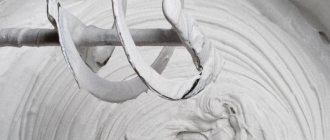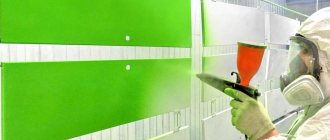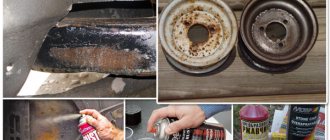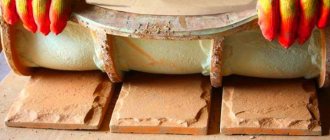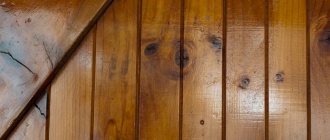Classification
Drying oils are divided into three large groups: oil, alkyd and synthetic.
Drying oils are natural, semi-natural and synthetic. Natural drying oil. It contains natural oil up to 97% - flaxseed, sunflower, soybean, etc.
The oil is filtered and during heat treatment it can undergo air-oxygen purging or not. Drying oil after air-oxygen blowing was called oxidized; without it, it was called polymerized. The drying oil obtained in this way lost its transparency, thickened and acquired a dark color. Salts of cobalt, lead, strontium, iron, and lithium are used as driers. But the content is small (up to 3%).
Drying oil oxol
Oxol has a natural oil content of up to 55%, the other components are solvent and drier. White spirit is used as a solvent - up to 40%, 5% is a drier.
Oxol has an unpleasant odor and can remain for some time even after drying. Oxol drying oil made from linseed oil is considered to be of high quality; oxol from sunflower oil has worse properties compared to linseed oil. Oxol is used both in interiors and on building facades, to cover garden furniture.
Combined drying oils
This is a solution in white spirit of a mixture of oxidized oils with dehydrated oils and drier. The combined drying oils include drying oil K-SKDP, which is a product of modification of sunflower drying oil with low molecular weight rubber SKDP; naphthopolymer drying oil - 55% solution of carbon-water resin in white spirit.
Alkyd drying oils
Alkyd drying oils are obtained by processing vegetable oils. Drying oils are classified according to the type of alkyd resin -
- glyphthalic
- xiftaleva
- pentaphthalic (made from sunflower, soybean and camelina oils; PF-K - using castor and tung oils).
Synthetic drying oils
Synthetic drying oils are solutions of shale oil, salts of naphthenic acids and some resins in organic solvents. So far, drying oils include: slate, synthol, ethinol, polydiene etc. Of these, only slate provides a weather-resistant film, therefore it is recommended for outdoor work. It is not used for interior painting because it has a strong odor. Drying oil ethinol forms a shiny hard film that is resistant to alkalis, acids, and water, but it is not weatherproof. It is used for anti-corrosion primer and as an additive to other drying oils (no more than 15%).
Soviet-made synthetic drying oils took a long time to dry, were poorly maintained on the surface, and over time cracked and crumbled. Synthetic drying oils are the most toxic in quality. There is a ban on their use in residential premises. They are used only for outdoor work, with restrictions - in temporary premises for adults, but with good ventilation.
It is advisable not to use them at all in rooms for children, the elderly and teenagers.
Types of drying oil
In order, as they say, to properly dilute drying oil, you need to know what types of this mixture exist, and how each type affects the appearance of the tree on which it will be applied in the future, as well as what properties it has. So, among all the existing drying oils, we can distinguish:
• natural; • synthetic; • semi-natural; • combined; • drying oils of the alkyd group.
The natural look is usually based on some kind of natural oil. Depending on the oils contained in it, you can find the following types:
• linen; • hemp; • castor; • based on regular sunflower oil.
The most popular among semi-natural drying oils in our time is oxol drying oil, which, in addition to oil, also contains a drying agent and a solvent. The combined type also contains the same necessary ingredients as the semi-natural one, the only difference being the proportions of these ingredients.
Drying oils from the group of alkyd resins, as a rule, contain a large percentage of solvent in their overall composition. Synthetic types are the cheapest, but at the same time, they have a rather detrimental effect on human health, since they are very toxic, so they are not recommended for use in enclosed spaces.
Drying oil for wood
Drying oil for wood is in demand today no less than in times of a total minimum of finishing materials - all the delights of oil paints, our older generation remembers them well; but in terms of horrors, you can also remember - when there was no choice, the walls were sometimes painted with nitro enamel (durable and ultimately beautiful, but you could breathe in oh-oh-oh). Drying oil for wooden cladding, frames, decor and other elements is a time-tested classic, both in the old days and today. Drying oils are distinguished by composition and properties, and there are only three main types of drying oils - natural drying oil, oxol and composites.
Natural drying oil
Natural drying oil is based on rapeseed oil (the cheapest), as well as sunflower, hemp or linseed oil. This composition indicates good environmental friendliness of the material. Natural drying oil has the least amount of adhesive (drier) - 3%; this additive is needed to make drying oil dry faster (everyone knows that this is a long process and cannot be compared with modern quick-drying paints). Natural drying oil is used to treat the inside of wooden walls of log houses, to dilute thick paints, to decorate furniture and various wood products. Natural drying oil is suitable for use in atmospheric conditions, but it is too expensive, there is oxol for this, and for non-critical structures on the street you can take a cheap composite - cheap and durable, although the smell is completely chemical, with a clean, almost imperceptible aroma of natural drying oil , corresponding to GOST - no comparison. (New standard for drying oils GOST 32389-2013, updated, but containing useful information GOST 7931-46)
Drying oil oxol
Oxol is also regulated, both production and composition (GOST 190-78). Application: indoors and outdoors, on wood and plaster. Oxol enhances adhesion and protects wood from bio-negativity. There are only 55% of natural oils in oxol, 5% of drier, plus solvent - gum turpentine, white spirit and others - in a volume of up to 40%. Oxol dries much faster than natural drying oil, and is not so expensive. Application of oxol:
- Impregnation of plastered substrates indoors and outdoors. A layer of drying oil slightly levels the walls, resulting in a reduction in the consumption of finishing paints and varnishes.
- To “revitalize” thickened oil paints, for dilution. There is more paint, which is economical, and the quality of the paint is no worse. Of course, only oil-based paints can be diluted with oxol.
- Never used for floor impregnation.
Based on their composition, oxol is divided into two types: Oxol B and Oxol PV. Both types of oxol are suitable for diluting paints, enhance the adhesion of paints to wood (plaster), and protect against harmful bio-factors. But Oxol PV is used only indoors, and Oxol V is used both indoors and outdoors. The secret is in the composition: Oxol B contains hemp and linseed oil in an amount of 55%, and Oxol PV is often produced using light petroleum-polymer resins, which is a synthetic analogue of natural oil. However, there are still manufacturers who use quite rare oils - grape, camelina, corn, safflower, and it is logical to use such drying oil for decoration, furniture, and handicrafts.
Drying oil combined
Composites made from drying oil are cheap and regulated by technical specifications, which already speaks for itself: the composition contains many petrochemical by-products, and most likely there are no natural oils at all. It is used only outdoors and preferably for the protection of non-residential buildings. Even if you want to save money, you don’t want to saturate a wooden gazebo with drying oil-composite - it has a very strong and persistent “chemical” smell. But the protective properties (against fungus and mold, beetles, rodents and atmospheric moisture) are excellent.
How to dilute drying oil if it has thickened?
Drying oil is a liquid substance, taken as a film, made using vegetable oils that have undergone special thermal and chemical treatment, or alkyd resins. It is used in the production of oil paints, putty, paint and varnish, and primer mixtures. It is used for impregnation and coating of wood to protect products from rotting, wood parasites and moisture. If you have thick drying oil on hand, you will soon find out how to dilute it.
Classification of drying oil
Depending on the composition and method of processing, drying oil is classified into the following types:
- natural drying oil;
- drying oil oxol (semi-natural);
- combined.
In the modern world, natural and semi-natural products are popular, while combined products are less in demand. Each type of oil drying oil is predisposed to hardening, and subsequently there is a need to dilute it. You can learn how to dilute drying oil yourself, without resorting to anyone’s help, from this article, having studied what components are included in its composition.
Natural drying oil
The composition of natural drying oil includes vegetable oils with the addition of substances that help accelerate its drying. In turn, drying oil, depending on the oils present in its composition, is divided into hemp, castor, tung, linseed and sunflower.
Natural drying oil has the properties of a solvent for paints and varnishes. The need to dilute such a composition occurs very rarely, since the oil can remain in a liquid state for a very long time and does not require adding a solvent.
The first subtype, drying oil containing hemp oils, has a darkish tint; hemp oil and solvent are used for its production. It has found its application in the construction industry: it is used for coating wood and metal products, plastered surfaces, as well as in the preparation of putty mixtures and oil paints.
Natural linseed oil is based on linseed oil using a solvent, which is also prepared from flax oils. Has a transparent tint. Used for priming various types of surfaces. Drying takes place within 24 hours.
Sunflower drying oil is elastic, but along with this quality there is another thing - hardness, strength and water resistance suffer, which cannot be said about hemp and linseed drying oil. The drying period is much longer.
How to dilute drying oil based on natural oils
It is worth remembering that natural drying oil is a substance with an increased fire hazard; if the rules and safety precautions are not followed, it can easily ignite. It is necessary to figure out how to dilute natural drying oil in everyday life. If you decide to resort to this, then you need to follow a number of rules: carry out the work process in a room with a functioning ventilation system, away from sources of ignition and only with proven liquids to dissolve thickened drying oil.
To dilute drying oil of this composition, castor oil, white spirit solvent, various organic acids, turpentine or solvents for oil-based paints are used. The dilution process is simple: you need to take a little oil drying oil and dilute it, observing the resulting reaction.
Drying oil oxol
The composition of semi-natural drying oil (oxol) includes natural vegetable oils and solvents that have undergone long-term heat treatment. Its composition is dominated by solvents, which is why the product has an unpleasant specific odor, which sometimes persists even after drying on the surface being treated. The color of the drying oil of the existing composition is light brown or brown. Has the property of drying quickly. The main task of this type of drying oil is to protect wooden surfaces from parasites and moisture; after covering the products with it, a protective film is formed. It has also become widespread in the paint and varnish industry; it is used in the production of paints and for diluting them in the process of performing interior and exterior painting work. The surfaces of products primed with such drying oil acquire a good shine, high strength, and become water resistant. In terms of cost, drying oil oxol is very economical and much more profitable than natural options.
How to dilute drying oil oxol
When diluting semi-natural drying oil, all fire safety requirements must be observed. Dilution work should be carried out away from sources of fire, in well-ventilated areas or equipped with ventilation systems. How to dilute drying oil and is it worth resorting to?
When diluting oxol, there is no need to hope for the preservation of its original physicochemical properties. Experts confirm that the process of breeding drying oil does not always end successfully. During this procedure, it is imperative to monitor the reaction you receive.
How to dilute semi-natural drying oil? It can be dissolved using white spirit, turpentine, nefras and other synthetic liquids that are used to dilute oil paints in proportions of 1:10.
Combined drying oils
Combined drying oils are obtained by combining synthetic drying oils with vegetable oils after undergoing heat treatment processes. Similar to semi-natural drying oils, they differ in the percentage of oil and solvent. They are used in the production of paints and varnishes, for the preparation of oil paints that are ready for use for painting work and for priming various products. The final drying period is no more than a day.
How are combined drying oils diluted?
When diluting drying oil of this composition, it is necessary to adhere to the recommendations of specialists and observe the correct execution of technological processes. How to dilute drying oil (thickened) of combined compositions is easy to answer - with the same solvent, white spirit. It is recommended to add only 1 part of solvent to 10 parts of base. After breeding, the loss of original properties and qualities is inevitable. But there will also be an increase in fluid properties, penetrating ability and viscosity will improve, drying oil with such a composition can be used in areas that do not require high-quality processing.
This article answered questions about how you can dilute drying oil at home, depending on the composition, what rules you need to follow when doing this work, what precautions you need to take.
Features of choice
When choosing the appropriate type of drying oil, you need to pay special attention to some nuances:
If possible, assess the degree of transparency of the liquid in the package. Natural drying oil, as seen in the photo, has a dark brown color and has no sediment.
Read the label carefully. It usually contains detailed information about the composition of the liquid, manufacturer, instructions for use, and so on.
You should definitely check the availability of a certificate of product quality, especially for natural drying oil.
High-quality drying oil is a transparent liquid, without sediment, pungent odor or foreign impurities. The color palette of drying oil is quite scarce; the color of the liquid varies from light brown to dark brown.
In order to achieve durability of the treated surfaces and significantly simplify the processing process, it is necessary to correctly select the optimal drying oil option. You can completely cope with the choice yourself, the most important thing is to take into account all the necessary parameters
Classification of drying oil
Depending on the composition and method of processing, drying oil is classified into the following types:
- natural drying oil;
- drying oil oxol (semi-natural);
- combined.
In the modern world, natural and semi-natural products are popular, while combined products are less in demand. Each type of oil drying oil is predisposed to hardening, and subsequently there is a need to dilute it. You can learn how to dilute drying oil yourself, without resorting to anyone’s help, from this article, having studied what components are included in its composition.
What it is?
Drying oil is a thick, oily liquid of predominantly brown color, consisting of a mixture of different components, intended for painting wood and preparing plastered surfaces for painting, and is also used as a solvent for oil paints.
Like any other product intended for processing, drying oil consists of basic and auxiliary substances. The basis of Oxol drying oil is vegetable oil, the share of which is in the range of 54-55% of the total mass.
Different oils can be used to make the product: flaxseed, hemp, sunflower, grape, soybean, corn or camelina. The base contains either one type or a mixture of several oils.
The share of additional components in the composition of "Oxol" accounts for 45% of the total mass, of which 40% is the solvent (white spirit is most often used), and the remaining 5% is driers. Each of them has certain properties that affect the composition as a whole.
The solvent gives the drying oil the desired consistency, and driers contribute to the rapid drying of the composition on the surface. Dryers are salts of various metals, or, more precisely, compounds of iron, cobalt, lead, lithium, strontium and many others with organic acids.
The composition of drying oil is not accidental; it is thanks to it that a stable film-forming coating is formed on the surface, which reliably protects the tree from the penetration of parasites that destroy the wood structure, and moisture, the influence of which leads to rotting processes. It not only performs a protective function, thereby extending the service life of the wooden surface, but also helps reduce the cost of paints and varnishes applied over the drying oil coating.
In order to understand how and due to what a film is formed on the surface, it is necessary to consider the principle of operation of drying oil, based on the properties of the components. Many types of vegetable oils used as a base are capable of thickening under certain conditions (oxygen, heat, light), and when applied to the surface in a thin layer, they can polymerize (dry out).
The formation of a semi-solid mass occurs due to polyunsaturated fatty acids present in some oils of plant origin. The rate of hardening on the surface is directly dependent on the size of glycerides of unsaturated fatty acids and such an indicator as iodine number. The higher the percentage of fatty acids in the oil and the higher the iodine value, the faster the polymerization process occurs.
But the natural oxidation process occurs slowly, and therefore drying oil is subjected to heat treatment along with the driers added to its composition. Heating of this composition leads to the decomposition of substances that slow down the formation of the film, and due to the presence of metal salts, the oxidation process occurs faster.
Drying agents affect the composition not only during the drying process, but also after it. It lasts as long as the layer remains on the surface; their share should not exceed 5%; a higher percentage of their content in the composition leads to darkening and then destruction of the film coating.
The formation of an elastic film on the surface occurs, as a rule, within 6-36 hours. This time difference is due to many factors: composition, preparation technology, presence of additives. Almost all drying oils known today take about a day to dry.
Cooking old drying oil
In order to return the substance to the necessary viscosity and properties, it is recommended to heat treat the old version of the composition. Especially for this purpose, provision is made for preparing the container and then pouring in the solution. Next, you need to add a small amount of drying agent, while regularly stirring the drying oil so that it does not turn out to be too thick. During the cooking process, the temperature is maintained around 150-170 degrees. The whole procedure lasts up to 2 hours, and the composition should be constantly stirred. Finally, you need to let the ingredient cool before using it directly.
1 / 5 ( 1 voice )
How to use drying oil to impregnate wood
With the help of drying oil you can greatly reduce the consumption of paints and varnishes and because of this it is used in the form of a primer mixture.
It is very easy to apply and does not require special knowledge. Simply apply it to the surface using a brush, natural rag, spray bottle or roller and let it dry.
There are many design options, but the most relevant are:
- Hot impregnation method. This procedure should be carried out in a water bath and is primarily suitable for impregnating non-bulky parts. To do this, take wood, place it in a container with a heated solution and soak it in it for about 6 hours. After this, the part is removed and dried for 4 to 6 days until completely dry. If you initially add about 2% of the total volume of red lead into the solution, the material will dry in two days.
- A mixture of drying oil and kerosene. To do this, take drying oil for wood and kerosene in equal proportions, mix it and keep the wood in this solution. This method can be either cold or hot. The only difference is that with hot impregnation, a few hours are enough, and with cold impregnation it will take a day. The coating dries after the procedure for no more than 2-3 days.
- Drying oil and bag. In order to treat wood with drying oil using this method, you should fill the bag with drying oil about 1/10 of the way. After this, you need to put the wooden element into the bag, wrap it and glue it tightly. The average impregnation time is 3-4 hours. After a while, the bag needs to be opened and since the wood should be completely saturated, the bag should be refilled. This is done until the part stops absorbing.
How are combined drying oils diluted?
When diluting drying oil of this composition, it is necessary to adhere to the recommendations of specialists and observe the correct execution of technological processes. How to dilute drying oil (thickened) of combined compositions is easy to answer - with the same solvent, white spirit. It is recommended to add only 1 part of solvent to 10 parts of base. After breeding, the loss of original properties and qualities is inevitable. But there will also be an increase in fluid properties, penetrating ability and viscosity will improve, drying oil with such a composition can be used in areas that do not require high-quality processing.
This article answered questions about how you can dilute drying oil at home, depending on the composition, what rules you need to follow when doing this work, what precautions you need to take.
How can you dilute drying oil?
Drying oil rarely thickens; it is mainly covered with a dry crust, which prevents it from thickening and drying out. Before use, you just need to remove the top layer.
And to make the drying oil even thinner, for example, for better impregnation or to increase the coverage area, you can add white spirit.
Oxol is a drying oil diluted with white spirit, where it is 55%, so it needs to be diluted with white spirit.
Usually drying oil is diluted with turpentine, although I recently read that this can be done with castor oil.
By the way, it is better to do this in a well-ventilated place, since drying oil is very flammable.
It is better to dilute this way: for 10 parts of drying oil, take 1 part of thinner.
That is, for a bucket of drying oil, you need to take a liter of thinner.
To be honest, as long as I have lived in the world, I never remember drying oil thickening. Drying oil is a natural oil (based on natural vegetable oils). And natural vegetable oils are, for example, sunflower oil. Can you imagine it thickening? This should take 5-10 years.
Well, if someone’s drying oil has already thickened, then you need to dilute it with natural solvents - solvents for oil paints (which are no longer available today!)
For example, white spirit, nefras, turpentine.
Add a little, otherwise you will end up with a very watery consistency.
I see that your tags say quot;oxolquot;. This is not what Oxol is for. It does not dilute or dissolve anything. This liquid is needed mainly to speed up the drying of oil paint. That is, if ordinary oil paint (real) takes 2-3 days to dry, then with oxol it takes about a day. If you add oxol to drying oil, it will dry out.
Drying oil is a protective composition that forms a film on the surface being treated. It contains various vegetable oils, sometimes tinting agents, minerals, and additives that increase the strength of the surface. As a rule, the combined composition is produced by boiling, oxidation, heating to certain temperatures, as a result of which all components dissolve and create a viscous, oily liquid.
Drying oil is a fire hazard, follow the safety rules for keeping it
Features and rules of use
This composition belongs to the category of quick-drying and quick-hardening substances, and therefore requires compliance with certain recommendations when working with it:
the mixture is sold in a ready-to-use form, but before using it directly, it is recommended to thoroughly mix the drying oil so that the active ingredients are evenly distributed throughout the liquid; impregnation can only be carried out on dry, clean and pre-degreased surfaces; it is necessary to apply the solution in a fairly thin layer, using a wide brush or small roller; the air temperature during work should not be below 15 and above 20 degrees, and humidity - no more than 75%; each layer of drying oil dries for about a day, so each new application should be carried out no later than 24 hours; It is very important, upon completion of work, to remove from the room all tools and materials that came into contact with drying oil;
- unused mixture can be stored for no more than 12 months in a hermetically sealed container;
- During work, it is recommended to use a respirator or protective mask and rubber gloves;
- if the composition gets on the skin or eyes, it must be thoroughly washed off with plenty of water;
- when carrying out work indoors, it is imperative to ensure access to fresh air;
- drying oil "Oxol" is highly flammable, so it should be used as far as possible from open sources of fire;
- when purchasing this product, you should definitely ask the seller for certificates of quality, safety and compliance with GOST requirements;
- This composition can also be used for sealing small cracks. To do this, drying oil is mixed with sawdust in equal proportions and applied to the surface to be treated using a spatula.
Following these simple rules and recommendations for using drying oil will allow you to process wooden and putty surfaces as simply, quickly and correctly as possible, and will also ensure a positive result.
Which drying oil is best for wood - we analyze the types of drying oil and answer 5 questions about its use
Partial or complete impregnation of wood with drying oil has been known since the times of the Egyptian pyramids, however, treating wood with drying oil is still relevant today. Next, we will look in detail at what types of drying oils there are and for what purposes certain types are used, plus you will learn recipes for mixtures based on drying oils and get answers to 5 frequently asked questions on this topic.
Coating wood with drying oil is considered one of the effective and repeatedly proven ways to protect wood.
What is drying oil
Drying oil is a film-forming substance based on natural, semi-natural or synthetic oil. The color range of the compositions ranges from golden yellow to dark brown. Depending on the type, drying oils have different levels of transparency.
Important! If the drying oil is dark and completely opaque, this indicates extremely low quality or you are being offered a crude fake.
To one degree or another, drying oil is used in all types of finishing work. It can be used as a primer for wood, concrete and metal. Thickly ground and oil paints are made from drying oil. It is added to putties and putties. When doing decorative work on wood, drying oil can act as an impregnation.
The use of drying oil for wood for exterior and interior use provides protection from moisture
Varieties of drying oils
A hundred years ago, drying oils were divided only by the type of natural oil from which they were made; now this area occupies no more than 30–40% of the total market, and semi-synthetic and synthetic compositions predominate on the market. In general, drying oils are divided into 4 types:
- Natural compositions;
- Semi-natural compositions;
- Combined formulations;
- Synthetic compounds.
Each composition was developed for its own, sometimes narrowly targeted purposes, so it is not correct to talk about good or bad drying oil
Natural compositions
Basically, drying oil is made from 3 types of oil - linseed, hemp and sunflower. Other types of natural oils are used extremely rarely; special formulations are often made from them for narrowly targeted purposes. All natural drying oils are guided by a single GOST 7931-76.
Important! In addition to dehydrated natural oil, a so-called drying agent is added to all types of drying oil; it acts as a hardener and takes up no more than 3–4% of the total composition.
| Photo | Characteristics |
| Flaxseed oil. |
Compositions based on natural linseed oil are considered the highest quality. There is nothing superfluous here, just boiled oil and a small percentage of drier.
· Used as a primer when finishing critical areas or processing expensive wood;
· Light paints, putties and putties are made from linseed oil;
If we take color, then sunflower drying oil will be the lightest and most transparent, followed by linseed oil, which is much darker. Hemp drying oil closes the ranking; it is the darkest.
Semi-natural compounds, oxols
Semi-natural drying oils are called oxols; they are made according to GOST 190-78. According to the rules, 55% is taken up by natural oil, 40% goes to the solvent (white spirit or nefras) and 5% to the dryer.
Oxols are considered universal compositions and can be used both for wood processing and for application to concrete or metal
There are 2 types of oxols, they are labeled as “B” and “PV”. Drying oil marked “B” is made from natural oil with the addition of a solvent and drier, and compositions marked “PV” also contain petrochemical additives that enhance certain characteristics.
It is not recommended to use oxols for treating wet rooms, for example, baths, but they are excellent for protecting wood, fiberboard and chipboard in dry rooms, plus oxols dry faster than natural compounds. The mechanical strength here is average, so it is not advisable to treat floors with oxols.
Oxols are an order of magnitude cheaper than natural types of drying oil
Combined formulations
Combined drying oils are regulated according to GOST 19007. They differ from oxols in the lower percentage of solvent in the composition, often this figure does not exceed 30%. Combined drying oils contain more modifiers and fewer toxic additives.
Important! Combined compositions are marked with the letter “K” and a numerical coefficient from 1 to 12. So, drying oils with even coefficients are intended for interior work, and with odd coefficients, for external work.
Combined types of drying oil are more focused on the preparation of paints and other compositions
Synthetic compounds
As the name implies, synthetic formulations are made based on artificial materials. For their production, oil and coal are used. Plus, synthetic drying oils are used as a by-product in the production of artificial types of rubber.
A distinctive feature of these compounds is their dark color and pungent chemical odor. Often, such drying oil is used to make putties for facade work. Synthetics cannot be used indoors, firstly, the smell practically does not dissipate, and secondly, there is a risk of poisoning for people.
It is highly undesirable to use polymer-based compositions for indoor work.
Alkyd drying oil is considered the only relatively high-quality polymer composition; up to 30% natural oils can be added to it. But it is not advisable to use these drying oils for interior work.
Important! The consumption of drying oil per 1 m2 of wood is approximately equal to the consumption of oil paint. According to the instructions, up to 130 g, but this is an average figure, so when processing dry and clean wood, it takes up to 250 g, and after applying 2 layers, the consumption is reduced to 100 g.
Selection tips and answers to 5 common questions
Do I need to dry wood before painting?
| Depends on what kind of paint will be applied. · For oil paints, treatment with drying oil is considered a mandatory procedure; · It is advisable to apply drying oil under alkyd compositions; Surface treatmentBefore applying drying oil, the wood must be cleaned and degreased with white spirit or acetone (25%). The massif must be dry; according to the rules, the maximum humidity is 16%. White spirit will allow you to clean the surface of the solid wood from serious contaminants and prepare the wood for subsequent finishing. Application and composition recipesDrying oil is applied in the same way as any paint, that is, using a brush, roller or swab. To apply it with a spray gun, the composition must be diluted, but it is better for an amateur not to undertake such work. Typically used for impregnation of small parts with natural compounds. The product is placed in a container with drying oil and heated in a water bath for 4 - 8 hours, drying time after hot impregnation is 4 - 5 days.
Take 5 parts drying oil, 1 part turpentine and 8 parts paraffin. If you are interested in impregnating wood with oil and wax, then all the recipes are “HERE” DryingThe drying time of drying oil depends on the type of composition itself, air humidity and temperature. So the optimal temperature for drying wood is 20 – 30ºС, with a relative humidity of up to 70%. Compositions with polymetallic drier dry best; for example, drying oil with the addition of lead drier dries in 20 hours, while manganese drier reduces the process to 12 hours. And if you mix both of these driers, the composition will dry in 8 hours. It is advisable to dry the wood indoors without drafts. There is no point in deliberately increasing the temperature using heaters or installing fans, as the coating may crack. It is better to dry wood indoors at a temperature of 25 - 30ºС Replacement of drying oilWhen performing high-quality decorative work, it is difficult to replace drying oil with anything, but if we are talking about rough work, then for these purposes you can use the folk recipe for casein impregnation. By the way, the coating looks decent and dries quickly.
During preparation, casein, soap solution and slaked lime are first mixed, then turpentine is added. At the finish we get a composition visually similar to drying oil. If the sediment “bounces off”, then you need to add a little ammonia. ConclusionIt is not for nothing that drying oil is considered one of the best ways to prepare wood, but when selecting a particular material, it is important to take into account the above-described properties of different compositions. In the video in this article you will find the opinions of different masters; if you want to share your own experience, welcome to the comments, such communication is useful for everyone. |
Using semi-natural drying oil - how to apply the composition?
Since Oxol has a pungent odor and belongs to the group of toxic oil compounds, we adhere to some mandatory rules when working with it. Firstly, we carry out the planned painting activities wearing a respirator, rubber gloves that protect our hands, and thick overalls. In this case, the risk of poisoning by drying oil vapors and contact of its drops with the skin is significantly reduced. If, nevertheless, Oxol lands on a person’s skin, it is necessary to immediately wipe it off with a clean rag. After this, thoroughly wash the damaged area with soapy water.
Secondly, work with drying oil indoors is allowed only if there is effectively functioning ventilation. The immediate scheme for processing wooden structures with Oxol looks like this:
- 1. We clean the product from the old coating (varnish, paint, etc.). We remove grease stains, dust and other contaminants from the surface.
- 2. Dry the cleaned structure. If there are significant roughnesses on its surface, we additionally sand the wood.
- 3. Open the jar of Oxol. Mix the composition well. If you are using a container from which the composition was taken earlier, add a little white spirit to the jar. Then we can easily stir the thickened mass.
- 4. Using a brush or roller, apply drying oil to the product. Make the layer not very thick.
- 5. We wait 24 hours. Then we re-paint the product with Oxol. If it is necessary to apply a third layer, wait another day. And only after this we treat the surface again with the described composition.
It is recommended to carry out work using oil compounds at air temperatures above 15 ° C, optimally at 22 ° C. That's all the wisdom of using Oxoli. Good luck!
How to dilute drying oil based on natural oils
It is worth remembering that natural drying oil is a substance with an increased fire hazard; if the rules and safety precautions are not followed, it can easily ignite. It is necessary to figure out how to dilute natural drying oil in everyday life.
If you decide to resort to this, then you need to follow a number of rules: carry out the work process in a room with a functioning ventilation system, away from sources of ignition and only with proven liquids to dissolve thickened drying oil.
To dilute drying oils of this composition, castor oil, white spirit solvent, various organic acids, turpentine or solvents for oil-based paints are used. The dilution process is simple: you need to take a little oil drying oil and dilute it, observing the resulting reaction.
Additional Information
All types of oils can be used to treat wooden surfaces
Particular attention should be paid to the place of application - drying oil for external use or for internal use.
Consumption
When treating wooden surfaces with drying oil, the following stages of work are distinguished:
- Preparatory work. It consists of preparing the surface for applying drying oil. It should be cleaned by hand from dirt and dust, degreased and any moisture removed.
- Application. A brush with softer bristles is best for application. If the amount of work is large, then a roller is used. The oil is applied generously so that the wood fibers are well saturated. If deep impregnation is required, use hot drying oil. To process one square meter of material you will need 130 ml of drying oil. Usually 2-3 layers are enough, but it all depends on the desired end result.
- Drying. The normal temperature for drying is 20 degrees. In this case, it is desirable to have a complete absence of drafts in the room. On average, wood treated with drying oil dries within 24 hours.
Paints and enamels are often very thick in consistency, so painting a surface with them can be difficult. In such cases, the paint is diluted with drying oil. It is added until the desired thickness is achieved. Thus, this method allows you to reduce paint consumption and save money.
Selection of drying oil
When buying drying oil you need to be careful
You should pay close attention to the color of the drying oil and packaging. The label must indicate the composition, GOST or TU number of the product
GOST indicates state level standards. It is advisable to check the certificate of conformity and hygiene certificate. The packaging must indicate the place and date of production and instructions for use.
A high-quality product does not have external mechanical damage to the container and does not contain sediment. The smell of the product, the weaker the better.
Type of drying oil
If your drying oil has thickened a little, you should accurately understand its type in order to dilute it correctly. It may contain various materials that have a natural or synthetic composition:
- Natural - based on vegetable oil, with the addition of natural ingredients (resins, esters, wax). As a rule, it has a high price because it does not evaporate toxic substances harmful to the body into the room.
- Semi-natural - synthetic components are added to the composition, increasing the wear resistance of the film, increasing the penetrating ability of the compositions, and the smoothness of the surface.
- Combined - compositions are created based on vegetable oils for preparing the surface to be painted. It is diluted with synthetic materials that are used for diluting acrylic paints, varnishes, primers, and glaze coatings.
- Synthetic is a completely artificial material that can color wood, be applied to walls, and other coatings.
Natural drying oils
They are the most common because, despite their safety and environmental friendliness, they have a fairly competitive price. Since they are produced on the basis of sunflower, linseed tung or other oils, they can act as a solvent. The need to dilute such a product rarely arises, since the oil remains in a liquid state for a long time, does not evaporate moisture, and does not require regular replenishment of the solvent. As a rule, natural drying oil has a transparent or light shade.
It is worth noting that the drying (absorption) time is about a day. Even when applied to metal structures, drying oil is very effective because it penetrates into pores, polarizes and reduces the consumption of the finishing coating significantly.
Natural drying oil is an excellent choice in terms of price and quality ratio
Typical places for application remain floor boards, wooden panels, structures, joists, and rafter systems. In order to reduce costs, natural drying oil can be diluted with ordinary vegetable oil. This will help when processing a large area where compliance with the work technology is not required. For example, when processing the floor in the attic, in the basement, processing slopes and sheathing on the roof.





